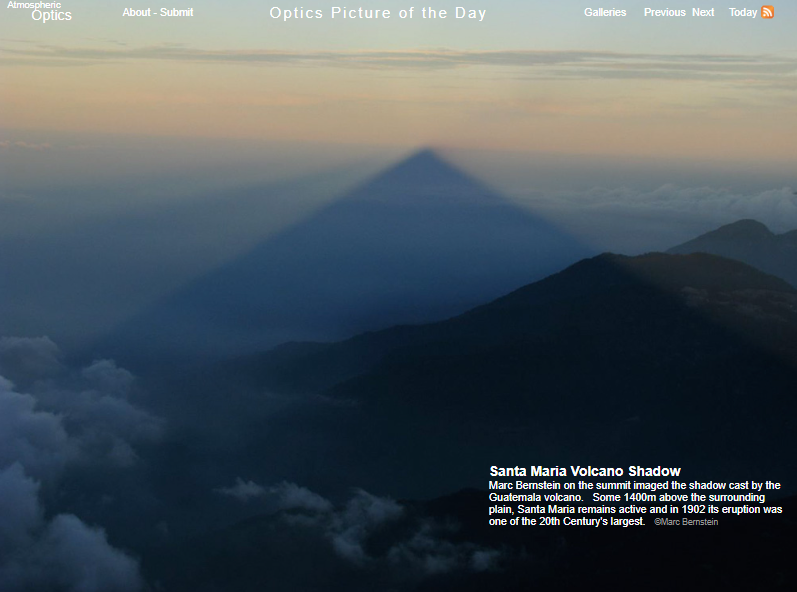Santa Maria Shadow
Santa Maria Shadow: A Fascinating Atmospheric Phenomenon
The Santa Maria Volcano, located in Guatemala, is not only a majestic sight to behold but also the source of a captivating atmospheric phenomenon known as the Santa Maria Shadow. This shadow, cast by the volcano, stretches for miles and creates a mesmerizing display of light and shadow. In this article, we will explore the intricacies of the Santa Maria Shadow and delve into the science behind its formation.
The Three-Dimensional Nature of Mountain Shadows
Contrary to popular belief, mountain shadows are not two-dimensional but rather three-dimensional phenomena. These shadows are not simply dark patches on the ground; they are elongated columns of unlit air that extend for tens of miles. When viewed from the summit of the shadow-casting mountain, these shadows appear triangular in shape, regardless of the mountain's actual profile.
The Triangular Nature of the Santa Maria Shadow
The Santa Maria volcano itself has a roughly triangular shape, which might lead one to assume that its shadow would mimic this shape. However, even if the volcano had a different profile, its shadow would still appear triangular when viewed from above. This is due to the nature of how light interacts with the atmosphere and creates these elongated shadow projections.
Understanding Shadow Convergence
To better comprehend the formation of mountain shadows, let's consider a hypothetical scenario involving a cubical mountain casting a shadow near sunset. Although the shadow may appear slightly convergent due to the sun's 0.5° diameter, it essentially takes on the shape of a long prism with a square cross-section. When observed from the top of the cube, the prism extends into the distance and appears triangular due to perspective.
The Influence of Sun Size on Shadow Shape
It is worth noting that the size of the sun plays a role in determining the shape of mountain shadows. The larger the sun's diameter, the more pronounced the convergence of the shadow becomes. This subtle effect adds an extra layer of complexity to the intricate interplay between light, shadow, and the Earth's topography.
The Santa Maria Volcano: A Historical Perspective
The Santa Maria volcano has a rich history, with its most notable eruption occurring in 1902. This eruption stands as one of the largest volcanic events of the 20th century. Since then, the volcano has remained active, continuously shaping the surrounding landscape and captivating observers with its awe-inspiring presence.
Atmospheric Optics: A Field of Wonders
The Santa Maria Shadow is just one example of the captivating phenomena that fall under the realm of atmospheric optics. This field of study explores the interactions between light and the Earth's atmosphere, revealing a multitude of mesmerizing visual displays. From rainbows and halos to mirages and iridescence, atmospheric optics constantly reminds us of the incredible beauty and complexity of our natural world.
The Magic of Perspective
Perspective plays a crucial role in how we perceive and interpret the Santa Maria Shadow. When viewed from a distance, the elongated triangular shape of the shadow creates a sense of depth and dimensionality. This optical illusion adds to the enchantment of the phenomenon, leaving observers in awe of nature's ability to deceive our senses.
A Source of Inspiration
The Santa Maria Shadow serves as a reminder of the immense power and beauty found in our natural surroundings. Its ethereal presence invites contemplation and reflection, evoking a sense of wonder and appreciation for the intricacies of our planet. As we gaze upon this captivating phenomenon, let us be inspired to explore further, unraveling the mysteries that lie hidden within our atmosphere.
Conclusion
The Santa Maria Shadow is a remarkable atmospheric phenomenon that showcases the interplay between light, shadow, and topography. Through its elongated triangular shape, it captures our imagination and invites us to marvel at the wonders of our natural world. As we continue to study and appreciate atmospheric optics, we uncover the hidden complexities and beauty that surround us, reminding us of the infinite mysteries waiting to be discovered.

Santa Maria Volcano Shadow
Marc Bernstein on the summit imaged the shadow cast by the Guatemala volcano. Some 1400m above the surrounding plain, Santa Maria remains active and in 1902 its eruption was one of the 20th Century's largest. ©Marc Bernstein

Mountain shadows are three- rather than two-dimensional. They are shafts of unlit air tens of miles long. From the shadow casting mountain's summit they all appear triangular regardless of the mountain profile. Santa Maria volcano is in fact roughly triangular but that does not matter, its shadow would be triangular anyway.
At right is a cubical mountain casting a shadow near to sunset. The shadow converges slightly because the sun is 0.5° in diameter but essentially it is a long prism of square cross-section. The second diagram shows the view of the shadow from the top of the cube. The prism extends away into the far distance and by perspective appears triangular.
Note: this article has been automatically converted from the old site and may not appear as intended. You can find the original article here.
Reference Atmospheric Optics
If you use any of the definitions, information, or data presented on Atmospheric Optics, please copy the link or reference below to properly credit us as the reference source. Thank you!
-
<a href="https://atoptics.co.uk/blog/santa-maria-shadow/">Santa Maria Shadow</a>
-
"Santa Maria Shadow". Atmospheric Optics. Accessed on November 26, 2024. https://atoptics.co.uk/blog/santa-maria-shadow/.
-
"Santa Maria Shadow". Atmospheric Optics, https://atoptics.co.uk/blog/santa-maria-shadow/. Accessed 26 November, 2024
-
Santa Maria Shadow. Atmospheric Optics. Retrieved from https://atoptics.co.uk/blog/santa-maria-shadow/.